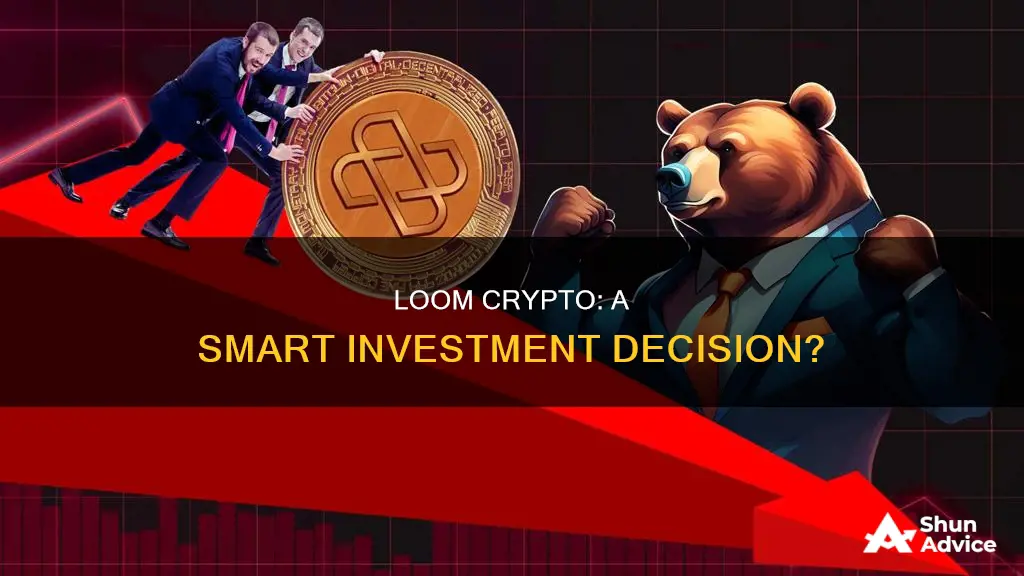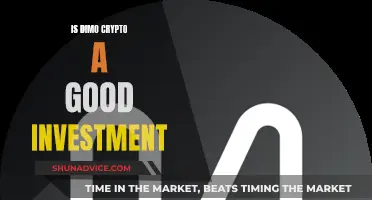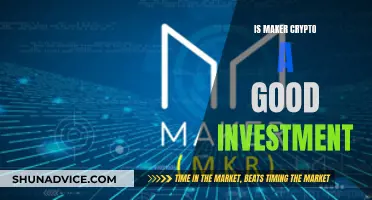
Loom Network (LOOM) is a blockchain-based platform that allows developers to create and launch high-performance decentralised applications (dApps) on multiple blockchains, including Bitcoin, Ethereum, and Binance Chain. It aims to solve the issue of scalability in blockchain technology, which often results in slower transactions and higher costs when there is increased activity on a blockchain. LOOM is the native currency of the Loom Network, and it can be used to pay for dApp hosting on the platform or staked in return for rewards. As of April 2024, the current price of LOOM is $0.1263, with a 24-hour trading volume of $56.152 million. In this article, we will explore the Loom Network in more detail and discuss its potential as an investment option.
What You'll Learn

Loom Network's price history and future predictions
Loom Networks Price History and Future Predictions
Price History
The Loom Network was founded in 2017 by developers Matthew Campbell, Luke Zhang, and James Martin Duffy. Its native token, LOOM, first came onto the open market in April 2018, with an initial value of $0.08949.
LOOM saw an early surge, reaching an all-time high of $0.7745 on 4 May 2018. However, it soon succumbed to the market forces of the crypto winter, falling below $0.10 in November 2018 and staying there for the next two years.
On 13 March 2020, in the midst of the Covid-19 pandemic, LOOM hit an all-time low of $0.007666. It then entered a bullish phase in April 2021, reaching a high of $0.2605. This was followed by a bearish summer, with the token hitting a low of $0.04078 on 21 June.
LOOM saw an upturn in August 2021, riding the wave of interest in non-fungible tokens (NFTs) and breaking through $0.10. It ended the month with a rally to $0.1777 on 17 September 2021. However, this was short-lived, and the token closed the year at $0.08578.
Things took a turn for the worse in 2022, with external events such as Russia's invasion of Ukraine and the collapse of the UST stablecoin and associated LUNA cryptocurrency sending the market into turmoil. LOOM dropped to $0.03642 on 12 May 2022 and then to a new low of $0.03153 on 15 June 2022, following news of the Celsius crypto lending platform cancelling withdrawals.
Future Predictions
The future of LOOM is uncertain, with analysts and forecasters offering varying predictions.
CryptoGround, for instance, took a bearish stance, predicting that LOOM could drop to $0.0495 in mid-September 2022 and reach $0.0449 by early to mid-October. They also forecasted that the token could be worth $0.0607 in mid-March 2023 and $0.0743 in August 2023. In the longer term, they predicted a LOOM price of $0.1197 in 2024, $0.3088 in 2025, and $0.4789 by September 2027.
CoinArbitrageBot, on the other hand, was more optimistic in the long term but bearish in the short term. They predicted that LOOM could fall to around $0.11 by the end of 2022, then move to $0.22 in 2023. They forecasted a steady rise in subsequent years, with a price of just under $0.36 in 2024, around $0.58 in 2025, and $1.73 in 2031.
PricePrediction's outlook was similar, with a predicted price of $0.058 in 2022, $0.081 in 2023, $0.12 in 2024, $0.17 in 2025, $0.24 in 2026, and $0.35 in 2027. They also forecasted a steady increase in the following years, with a price of $1.15 in 2030 and $1.73 in 2031.
WalletInvestor, however, was far more bearish, arguing that LOOM's value could drop significantly by September 2023, falling to around $0.0692.
It's important to note that cryptocurrency markets are extremely volatile, and predictions can often be wrong. As such, it's crucial to do your own research and consult with a financial advisor before making any investment decisions.
Should You Invest in OCN Coin?
You may want to see also

Loom Network's unique value proposition
Loom Network is a Platform-as-a-Service (PaaS) built on Ethereum, allowing developers to run large-scale decentralized applications (DApps) with high transaction throughput and fast confirmation times. Its unique value proposition lies in its ability to address the scalability and speed issues prevalent in most blockchain networks. Here are the key elements that make Loom Network stand out:
Speed and Scalability:
Loom Network's infrastructure is designed to provide speed and scalability, offering a solution to one of the main issues in the blockchain and cryptocurrency space. By leveraging Plasma sidechains, Loom Network enables faster transactions and can handle a large number of transactions without congesting the network. This makes it ideal for applications that require high transaction throughput, such as online games and social apps.
Ethereum Compatibility:
Loom Network is built on top of Ethereum, allowing developers to create DApps using the Solidity programming language. This compatibility with Ethereum's ecosystem and smart contracts provides a secure and trusted foundation for DApp development. Loom Network's DAppChains can run side-by-side with Ethereum smart contracts, ensuring seamless integration.
Easy Integration with Third-Party APIs:
Loom Network allows developers to interact with APIs developed by third parties that are not on the blockchain. This enables developers to leverage off-chain resources, such as Google Authenticator for 2-factor authentication, enhancing the functionality and user experience of their DApps.
User-Friendly Access:
Loom Network's DApps do not require users to download crypto wallets, lowering the barrier to entry and attracting a broader audience, including those who may not be interested in blockchain technology otherwise. This user-friendly approach aligns with their goal of bringing crypto and blockchain to the mainstream.
Token Utility:
The LOOM token has multiple use cases within the Loom Network ecosystem. It is used to pay for dApp hosting on the platform, can be staked to secure the network and earn rewards, and also functions as a membership token, granting access to all apps running on the Loom Network.
Focus on Gaming and Social Apps:
Loom Network is particularly well-suited for gaming and social app development. Its infrastructure enables the creation of massive gaming worlds similar in scope to MMORPGs like World of Warcraft. Additionally, social apps built on Loom Network can offer unique features, such as monetization with karma tokens and expansion through multiple-client apps.
Developer-Friendly Tools:
Loom Network provides a software development kit (SDK) that empowers developers to rapidly code and deploy Ethereum blockchain-based DApps without needing to become blockchain experts first. This lowers the technical barrier for developers interested in building decentralized applications.
Quant Crypto: Worth the Investment Risk?
You may want to see also

Loom Network's team and funding
The Loom Network was founded by Matthew Campbell, Luke Zhang, and James Duffy in 2017 as a Platform as a Service (PaaS). It is based in Bangkok, Thailand, and previously secured $25 million in funding from The Ventures, a China-based venture capital firm. The Loom Network is a unique project that aims to be the premier Ethereum-based gaming and social app development platform.
The Loom Network's unique selling point is its ability to solve the scalability issues faced by most blockchain networks. It does this by offering more processing power, lower prices, and a network architecture that can handle unlimited transactions. This makes it easier for developers to create decentralised applications (dApps) and brings blockchain and crypto closer to the mainstream.
The Loom Network also claims to be able to integrate assets in a cross-chain manner, meaning that people can use Bitcoin (BTC) on the platform, which is based on the Loom Network Basechain. The LOOM token is used to pay for dApp hosting on the platform and can also be staked in return for rewards. It is an ERC-20 token and has been integrated with Binance Chain so it can be used as a BEP-2 token.
The Loom Network team does not seem to put much focus on publicising its members, instead preferring to let the development of the project speak for itself. However, co-founder Matthew Campbell is still with the project as the CEO, and James Duffy is the Chief Marketing Officer. There are 35 employees listed on LinkedIn.
The LOOM token first came onto the open market in April 2018 after a private initial coin offering (ICO) which raised $45.81 million out of a target of $57 million. There are 1.3 billion Loom Network tokens in circulation, giving the token a market cap of around $169 million, making it the 155th largest crypto by that metric.
Crypto Investment: Risky Business or Smart Money Move?
You may want to see also

Loom Network's benefits
Loom Network (LOOM) is a multichain interop platform that enables developers to create and distribute high-performance decentralised applications (dApps) with a smooth user experience. It is built on the Ethereum blockchain and aims to address the issue of scalability that many blockchains face. Here are some benefits of the Loom Network:
- Speed and Scalability: Loom Network improves the speed and scalability of Ethereum-based dApps. It achieves this by using Plasma, a scaling solution that enables faster transactions across the network. Loom's infrastructure can handle a large number of transactions without sacrificing security, ensuring that dApps run efficiently even during peak demand.
- Ease of Development: Loom Network provides developers with the tools and resources needed to build and deploy dApps without requiring them to become blockchain experts. Its software development kit (SDK) allows for rapid coding and deployment of dApps, making it easier for developers to enter the blockchain space.
- Cross-Chain Compatibility: Loom Network allows developers to run large-scale dApps on multiple blockchains, including Bitcoin, Ethereum, Binance Chain, and Tron. This cross-chain compatibility gives developers flexibility and the ability to reach a wider audience.
- Transparent and Censorship-Resistant: Loom Network promotes transparency and censorship resistance. It enables decentralised applications to function similarly to traditional computer and phone programs, making crypto and blockchain more accessible and user-friendly.
- User Accessibility: Loom Network eliminates the need for users to download crypto wallets to access dApps. This lowers the barrier to entry and makes it more convenient for people to interact with blockchain technology and dApps.
- Staking Rewards: LOOM token holders can stake their tokens to secure the network and earn rewards. Staking provides an incentive for users to participate in the network and contributes to the network's overall security and decentralisation.
- Broad Adoption: Loom Network has already attracted a number of developers who have built gaming dApps on the platform. This has increased the adoption of the network, demonstrating its potential to become a premier platform for gaming and social app development.
- Smart Contract Integration: Loom Network allows developers to integrate smart contracts into their dApps. This enables advanced functionality, such as provably scarce items in games and monetisation through karma tokens in social apps.
- Community-Driven: Loom Network emphasises community involvement in the development and governance of dApps. This democratic approach gives users a say in the direction of the network and the dApps that run on it.
- Interoperability: Loom Network's use of sidechains, known as DAppChains, enhances interoperability. These sidechains run parallel to Ethereum smart contracts, allowing for seamless integration and the ability to interact with multiple blockchains.
Trump-Kim Commemorative Coin: Worthy Investment or Waste?
You may want to see also

Loom Network's competitors
Loom is a screen recorder that helps users record quick video messages to share with their team. However, Loom has its limitations, including a non-intuitive user interface, limited editing capabilities, and a free version that restricts users to 25 videos with a maximum length of five minutes. Here are some of Loom's competitors:
Sendspark
Sendspark is a video platform for creating personalized videos for sales and customer communication. It offers templates, branding support, and analytics features. Sendspark is great for creating a lot of similar videos quickly, such as for sales prospecting, onboarding, customer success, and support. However, it is designed for customer communication, so other platforms may be better for internal communication.
Snagit
Snagit is a screen capture and recording software that allows users to capture the screen and camera, add context, and share images, GIFs, or videos across preferred platforms. It has a panoramic scrolling capture feature and annotations to add text or draw on videos. However, Snagit does not have a free plan, and its paid plans may be expensive for small businesses.
Camtasia
Camtasia is a screen recording and video editing software designed for creating video tutorials and instructional content. It offers screen recording options, pre-built video templates, and a library of royalty-free music and sound effects. However, Camtasia can be expensive compared to similar tools, and it requires training to create content effectively.
ScreenRec
ScreenRec is a lightweight screen recording and screenshot app that offers hefty features. It allows users to record their screen, computer audio, and webcam in HD or 4K, with simple annotation tools and an automatic shareable link. However, ScreenRec does not have a pause button to temporarily stop recordings, and it lacks video editing features.
Vidyard
Vidyard is a screen recording platform offered as a Chrome browser extension. It enables video sharing via email, social media, and embedded links. It also provides engagement notifications and video optimization features. However, Vidyard's user interface can be confusing for new users, and it is offered at a premium price with limited editing capabilities.
Zight (formerly CloudApp)
Zight is a screen recording software that allows users to capture their screen and webcam and share it instantly to the cloud. It supports annotations, GIF creation, and link sharing. However, Zight's free plan restricts video length to 90 seconds, and it does not offer video editing capabilities.
Buffett's Bitcoin: The Oracle's Crypto Investment Strategy
You may want to see also
Frequently asked questions
Loom Network (LOOM) is a multichain interoperable platform for developers to build and launch high-performance decentralised applications. It is an Ethereum side-chain that powers a wide range of decentralised applications.
The Loom Network allows developers to run large-scale decentralised applications on multiple blockchains, including Bitcoin, Ethereum, Binance Chain and Tron. It offers fast and low-cost transactions on its PlasmaChain network.
The LOOM token is a proof-of-stake token used to secure the LOOM Network's mainnet, called Basechain. It can be used to pay for dApp hosting on the LOOM Network and can also be staked in return for rewards.
The Loom Network offers frictionless user experiences with extremely fast and free transactions. It also grants access to a massive user base, allowing dApp developers to reach a wider audience.
Loom Crypto could be a good investment option for virtual currencies with good returns. However, it is a high-risk investment option. While some analysts predict the coin's value will rise, others disagree. It is important to remember that projections, especially long-term projections, are not conclusive. The cryptocurrency market is highly volatile and unpredictable, so it is always good to do your own research and consult a financial advisor before making any investment decisions.







